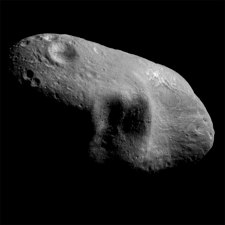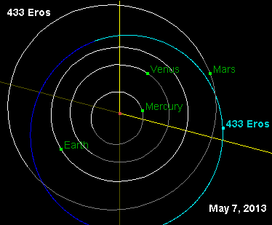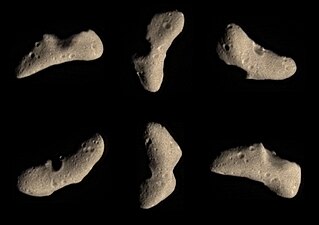astro.wikisort.org - Asteroid
Eros (minor planet designation: (433) Eros), provisional designation 1898 DQ, is a stony asteroid of the Amor group and the first discovered and second-largest near-Earth object with an elongated shape and a mean diameter of approximately 16.8 kilometers (10.4 miles). Visited by the NEAR Shoemaker space probe in 1998, it became the first asteroid ever studied from orbit around the asteroid.
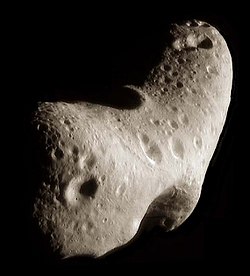 Eros – composite image of the north polar region, with the craters Psyche above and Himeros below. The long ridge Hinks Dorsum, believed to be a thrust fault, can be seen snaking diagonally between them. The smaller crater in the foreground is Narcissus Watters, (2011) | |
| Discovery [1] | |
|---|---|
| Discovered by | G. Witt |
| Discovery site | Berlin Urania Obs. |
| Discovery date | 13 August 1898 |
| Designations | |
MPC designation | (433) Eros |
| Pronunciation | /ˈɪərɒs/[2] |
Named after | Ἔρως, Érōs[3] |
Alternative designations |
|
Minor planet category |
|
| Adjectives | Erotian /ɛˈroʊʃ(i)ən/ |
| Orbital characteristics [1] | |
| Epoch 4 September 2017 (JD 2458000.5) | |
| Uncertainty parameter 0 | |
| Observation arc | 53.89 yr (19,683 days) |
| Earliest precovery date | 29 October 1893 |
| Aphelion | 1.7825 AU |
| Perihelion | 1.1334 AU |
Semi-major axis | 1.4579 AU |
| Eccentricity | 0.2226 |
Orbital period (sidereal) | 1.76 yr (643 days) |
Mean anomaly | 71.280° |
Mean motion | 0° 33m 35.64s / day |
| Inclination | 10.828° |
Longitude of ascending node | 304.32° |
Argument of perihelion | 178.82° |
| Earth MOID | 0.1505 AU (58.6 LD) |
| Mars MOID | 0.2407 AU |
| Physical characteristics | |
| Dimensions | |
| Mass | (6.687±0.003)×1015 kg[4] |
Mean density | 2.67±0.03 g/cm3[1][4] |
Synodic rotation period | 5.270 h[1] |
Geometric albedo | 0.25±0.06[1] |
Spectral type | |
Apparent magnitude | 7.0–15[6] |
Absolute magnitude (H) | 11.16[1] |
The asteroid was discovered by German astronomer C.G. Witt at the Berlin Observatory on 13 August 1898 in an eccentric orbit between Mars and Earth. It was later named after Eros, a god from Greek mythology, the son of Aphrodite. He is identified with the planet Venus.[3]
History
Discovery
Eros was discovered on 13 August 1898 by C.G. Witt at Berlin Urania Observatory and A. Charlois at Nice Observatory.[7] Witt was taking a two-hour exposure of beta Aquarii to secure astrometric positions of asteroid 185 Eunike.[8]
Name
Eros is named after the Greek god of love, Erōs. It is pronounced /ˈɛrɒs/ ERR-os or sometimes /ˈɪərɒs/ EER-os. The rarely used adjectival form of the name is Erotian /ɪˈroʊʃən/.[9][3]
Eros was the first minor planet to be given a male name,[3] on account of its orbit (it was the first near-Earth asteroid discovered).
Later studies
During the approach (opposition) of 1900–1901, a worldwide program was launched to make parallax measurements of Eros to determine the solar parallax (or distance to the Sun), with the results published in 1910 by A. Hinks of Cambridge[10] and C.D. Perrine of the Lick Observatory, University of California.[11] Perrine published progress reports in 1906[12] and 1908.[13] He took 965 photographs with the Crossley Reflector and selected 525 for measurement.[14] A similar program was then carried out, during a closer approach, in 1930–1931 by H.S. Jones.[15] The value of the Astronomical Unit (roughly the Earth-Sun distance) obtained by this program was considered definitive until 1968, when radar and dynamical parallax methods started producing more precise measurements.
Eros was the first asteroid detected by the Arecibo Observatory's radar system.[16][17]
Eros was one of the first asteroids visited by a spacecraft, the first one orbited, and the first one soft-landed on. NASA spacecraft NEAR Shoemaker entered orbit around Eros in 2000, and landed in 2001.
Mars-crosser
Eros is a Mars-crosser asteroid, the first known to come within the orbit of Mars. Objects in such an orbit can remain there for only a few hundred million years before the orbit is perturbed by gravitational interactions. Dynamical integrations suggest that Eros may evolve into an Earth-crosser within as short an interval as two million years, and has a roughly 50% chance of doing so over a time scale of 108~109 years.[18] It is a potential Earth impactor,[18] about five times larger than the impactor that created Chicxulub crater and led to the extinction of the non-avian dinosaurs.[lower-alpha 1]
NEAR Shoemaker survey and landing
The NEAR Shoemaker probe visited Eros twice, first with a brief flyby in 1998, and then by orbiting it in 2000, when it extensively photographed its surface. On 12 February 2001, at the end of its mission, it landed on the asteroid's surface using its maneuvering jets.
This was the first time a Near Earth asteroid was closely visited by a spacecraft.[19]
 Animation of NEAR Shoemaker trajectory from 19 February 1996 to 12 February 2001..
Animation of NEAR Shoemaker trajectory from 19 February 1996 to 12 February 2001..- NEAR Shoemaker
- Eros
- Earth
- Mathilde
- Sun
 Animation of NEAR Shoemaker's trajectory around 433 Eros from 1 April 2000 to 12 February 2001.
Animation of NEAR Shoemaker's trajectory around 433 Eros from 1 April 2000 to 12 February 2001.
NEAR Shoemaker · 433 Eros
Physical characteristics
Surface gravity depends on the distance from a spot on the surface to the center of a body's mass. Eros's surface gravity varies greatly because Eros is not a sphere but an elongated peanut-shaped object. The daytime temperature on Eros can reach about 100 °C (373 K) at perihelion. Nighttime measurements fall near −150 °C (123 K). Eros's density is 2.67 g/cm3, about the same as the density of Earth's crust. It rotates once every 5.27 hours.
NEAR scientists have found that most of the larger rocks strewn across Eros were ejected from a single crater in an impact approximately 1 billion years ago.[20] (The crater involved was proposed to be named "Shoemaker", but is not recognized as such by the International Astronomical Union (IAU), and has been formally designated Charlois Regio.) This event may also be responsible for the 40 percent of the Erotian surface that is devoid of craters smaller than 0.5 kilometers across. It was originally thought that the debris thrown up by the collision filled in the smaller craters. An analysis of crater densities over the surface indicates that the areas with lower crater density are within 9 kilometers of the impact point. Some of the lower density areas were found on the opposite side of the asteroid but still within 9 kilometers.[21]
It is theorized that seismic shockwaves propagate through the asteroid, shaking smaller craters into rubble. Since Eros is irregularly shaped, parts of the surface antipodal to the point of impact can be within 9 kilometres of the impact point (measured in a straight line through the asteroid) even though some intervening parts of the surface are more than 9 kilometres away in straight-line distance. A suitable analogy would be the distance from the top centre of a bun to the bottom centre as compared to the distance from the top centre to a point on the bun's circumference: top-to-bottom is a longer distance than top-to-periphery when measured along the surface but shorter than it in direct straight-line terms.[21]
Compression from the same impact is believed to have created the thrust fault Hinks Dorsum.[22]
Data from the Near Earth Asteroid Rendezvous spacecraft collected on Eros in December 1998 suggests that it could contain 20 billion tonnes of aluminum and similar amounts of metals that are rare on Earth, such as gold and platinum.[23]
Visibility from Earth

On 31 January 2012, Eros passed Earth at 0.17867 AU (26,729,000 km; 16,608,000 mi),[24][25] about 70 times the distance to the Moon, with a visual magnitude of +8.1.[26] During rare oppositions, every 81 years, such as in 1975 and 2056, Eros can reach a magnitude of +7.0,[6] which is brighter than Neptune and brighter than any main-belt asteroid except 1 Ceres, 4 Vesta and, rarely, 2 Pallas and 7 Iris. Under this condition, the asteroid actually appears to stop, but unlike the normal condition for a body in heliocentric conjunction with Earth, its retrograde motion is very small. For example, in January and February 2137, it moves retrograde only 34 minutes in right ascension.[1]
In popular culture
In the novel and television series The Expanse, a catastrophic science experiment is unleashed on a civilian population living within tunnels cut through Eros. This so-called "Eros Incident" ends with the asteroid mysteriously breaking its usual orbit and crashing into Venus.[27]
It makes an appearance in the novel Ender's Game by Orson Scott Card, serving as a base for humanity.[28]
Gallery
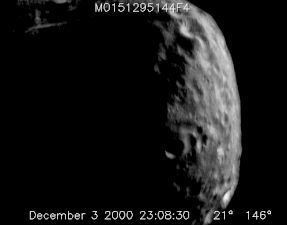 Animation of the rotation of Eros
Animation of the rotation of Eros- View from one end of Eros across the gouge on its side towards the opposite end
- First mosaic image of Eros taken from an orbiting spacecraft
- Mosaic image of Eros
- At 4.8 km (3.0 mi) across, the crater Psyche is Eros's second largest.
- Regolith of Eros, seen during NEAR's descent; area shown is about 12 meters (40 feet) across
- Orbital diagram of Eros with locations on 7 May 2013
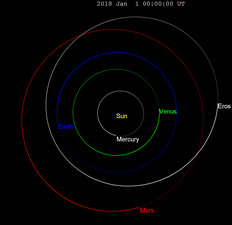 Orbital diagram of Eros with locations on 1 January 2018
Orbital diagram of Eros with locations on 1 January 2018- Six different views of Eros in approximate natural color from NEAR-Shoemaker in February 2000
- Stereo image of Eros
See also
- List of geological features on 433 Eros
- Lists of astronomical objects
Notes
- Ratio of mean diameters is 16.84 km/~10 km; the volume ratio is approximately 4.8 (cubed value).
References
- 433 Eros (1898 DQ). JPL Small-Body Database Browser (last obs.). Jet Propulsion Laboratory. 4 June 2017. Retrieved 16 August 2017.
- "Eros". Oxford English Dictionary (Online ed.). Oxford University Press. (Subscription or participating institution membership required.)
- Schmadel, Lutz D. (2007). "(433) Eros". Dictionary of Minor Planet Names. Springer Berlin Heidelberg. p. 50. doi:10.1007/978-3-540-29925-7_434. ISBN 978-3-540-00238-3.
- Yeomans, D.K.; Antreasian, P.G.; Barriot, J.-P.; Chesley, S.R.; Dunham, D.W.; Farquhar, R.W.; et al. (September 2000). "Radio science results during the NEAR-Shoemaker spacecraft rendezvous with Eros". Science. 289 (5487): 2085–2088. Bibcode:2000Sci...289.2085Y. doi:10.1126/science.289.5487.2085. ISSN 0036-8075. PMID 11000104.
- Baer, Jim (2008). "Recent asteroid mass determinations". earthlink.net (personal website). Archived from the original on 29 January 2009. Retrieved 11 December 2008.
- "NEODys (433) Eros ephemerides for 2137". Department of Mathematics. Pisa, Italy: University of Pisa. Retrieved 27 June 2010.
- Scholl, Hans; Schmadel, Lutz D. (2002). "Discovery circumstances of the first near-Earth asteroid (433) Eros". Acta Historica Astronomiae. 15: 210–220. Bibcode:2002AcHA...15..210S.
- Yeomans, Donald K. (2014). Asteroid 433 Eros: The target body of the NEAR Mission (PDF). Jet Propulsion Laboratory (Report). California Institute of Technology. Archived from the original (PDF) on 28 September 2007.
- Asimov, Isaac (1988). The Asteroids. A Gareth Stevens children's book. Milwaukee, MN: Gareth Stevens Pub. ISBN 978-1555323783. OCLC 17301161.
- Hinks, A.R. (1909). "Solar Parallax Papers no. 7: The general solution from the photographic right ascensions of Eros, at the opposition of 1900". Monthly Notices of the Royal Astronomical Society. 69 (7): 544–67. Bibcode:1909MNRAS..69..544H. doi:10.1093/mnras/69.7.544.
- Perrine, Charles D. (1910). Determination of the solar parallax from photographs of Eros made with the Crossley reflector of the Lick Observatory, University of California (Report). Washington, DC: Carnegie Institution of Washington. pp. 1–104.
- Perrine, C.D. (1906). "The measurement and reduction of the photographs of Eros made with the Crossley Reflector in 1900". Publications of the Astronomical Society of the Pacific. 18 (10): 226.
- Perrine, Charles D. (1908). "Progress on the Crossley Eros solar parallax work". Publications of the Astronomical Society of the Pacific. 20 (120): 184. Bibcode:1908PASP...20..184P. doi:10.1086/121816.
- Campbell, W.W. (1906). "Reports of the observatories: Lick Observatory". Publications of the Astronomical Society of the Pacific. 19 (113): 92.
- Jones, H.S. (1941). "The solar parallax and the mass of the Moon from observations of Eros at the opposition of 1931". Memoirs of the Royal Astronomical Society. 66: 11–66.
- Butrica, Andrew J. (1996). To See the Unseen: A history of planetary radar astronomy (2nd ed.). Washington, DC: National Aeronautics and Space Administration. p. 224. ISBN 978-0160485787.
- "Introduction to asteroid radar astronomy". Los Angeles, CA: University of California, Los Angeles. Retrieved 19 May 2014.
- Michel, Patrick; Farinella, Paolo; Froeschlé, Christiane (25 April 1996). "The orbital evolution of the asteroid Eros and implications for collision with the Earth". Nature. 380 (6576): 689–691. Bibcode:1996Natur.380..689M. doi:10.1038/380689a0. S2CID 4354612.
- Svitil, Kathy A. (February 2001). "The end is near: The remarkable journey of a tough little space probe to the place where killer asteroids lurk". Discover Magazine. Retrieved 30 September 2019 – via DiscoverMagazine.com.
- Thomas, P.C.; Veverka, J.; Robinson, M.S.; Murchie, S. (27 September 2001). "Shoemaker crater as the source of most ejecta blocks on the asteroid 433 Eros". Nature. 413 (6854): 394–396. Bibcode:2001Natur.413..394T. doi:10.1038/35096513. ISSN 0028-0836. PMID 11574880. S2CID 4325299.
- Thomas, P.C.; Robinson, M.S. (21 July 2005). "Seismic resurfacing by a single impact on the asteroid 433 Eros". Nature. 436 (7049): 366–369. Bibcode:2005Natur.436..366T. doi:10.1038/nature03855. PMID 16034412. S2CID 4425770.
- Watters, T.R.; Thomas, P.C.; Robinson, M.S. (2011). "Thrust faults and the near-surface strength of asteroid 433 Eros". Geophysical Research Letters. 38 (2): L02202. Bibcode:2011GeoRL..38.2202W. doi:10.1029/2010GL045302. ISSN 0094-8276.
- "Gold rush in space?". BBC News. Retrieved 13 December 2014.
- 433 Eros (1898 DQ) (last obs). JPL Close-Approach Data. 13 November 2011. Retrieved 14 November 2011.
- "NEODyS-2 close approaches for (433) Eros". NEODyS-2 Near Earth Objects. European Space Agency / University of Pisa / Space Dynamics Service S.R.L. Retrieved 14 November 2011.
- "AstDys (433) Eros ephemerides for 2012". Department of Mathematics. Pisa, Italy: University of Pisa. Retrieved 27 June 2010.
- https://www.space.com/the-expanse-seasons-1-3-recap.html
- Ender's Game and Philosophy: The Logic Gate is Down. John Wiley & Sons. 2013. p. 117.
Further reading
- Clark, C.S.; Clark, P.E. (13–17 March 2006). Using boundary-based mapping projections to reveal patterns in depositional and erosional features on 433 Eros. 37th Annual Lunar and Planetary Science Conference. League City, Texas. p. 1189. Bibcode:2006LPI....37.1189C. Abstract no.1189.
- Riner, M. A.; et al. (November 2008). "Global survey of color variations on 433 Eros: Implications for regolith processes and asteroid environments". Icarus. 198 (1): 67–76. Bibcode:2008Icar..198...67R. doi:10.1016/j.icarus.2008.07.007.
External links
This section's use of external links may not follow Wikipedia's policies or guidelines. (October 2018) |
- NEAR Shoemaker spacecraft
- NEAR image of the day archive
- Movie: NEAR Shoemaker spacecraft landing
- The Eros Project (OrbDev's attempts at litigation over their property claim)
- 3D VRML 433 Eros Model
- 3D shape model of Eros (requires WebGL)
- NEODys (saved output file from 2007) showing distance and magnitude Ephemerides for Eros during rare oppositions
- The Chicxulub Debate In relation to the K-T extinction.
- Dearborn Observatory Records, Northwestern University Archives, Evanston, Illinois Notations as to historical archived work on asteroid 433 Eros.
- Eros at Opposition in 2012 (Royal Astronomical Society of New Zealand)
- NEAR database by ASU (Image search) (Example)
- Eros nomenclature and Eros map with feature names from the USGS planetary nomenclature page
- 433 Eros at NeoDyS-2, Near Earth Objects—Dynamic Site
- 433 Eros at AstDyS-2, Asteroids—Dynamic Site
- 433 Eros at the JPL Small-Body Database
На других языках
[de] (433) Eros
(433) Eros ist ein Asteroid, der am 13. August 1898 von dem deutschen Astronomen Gustav Witt mit dem Bamberg-Refraktor in Berlin entdeckt wurde. Er war der erste bekannte erdnahe Asteroid und wurde 1900 und 1930 zur genauen Bestimmung des Erdbahn-Radius verwendet, analog zu Venustransits.- [en] 433 Eros
[es] (433) Eros
(433) Eros es un asteroide que forma parte de los asteroides Amor y fue descubierto por Carl Gustav Witt (1866-1946) en 1898. Tiene un perihelio de 1,1 UA, distancia que lo aproxima periódicamente a la Tierra, y es, por tanto, un asteroide próximo a la Tierra (NEA). Desde el punto de vista químico, está clasificado como un asteroide de tipo S, formado por asteroides compuestos de silicatos.[fr] (433) Éros
(433) Éros est un astéroïde du système solaire. Il a été découvert le 13 août 1898 par Auguste Charlois et Carl Gustav Witt, de façon indépendante, et nommé d'après la divinité de l'amour de la mythologie grecque.[ru] (433) Эрос
(433) Эрос (др.-греч. Ἔρως) — околоземный астероид из группы Амура (I), принадлежащий к светлому спектральному классу S. Он был открыт 13 августа 1898 года германским астрономом Карлом Виттом в обсерватории Урания[5] и назван именем Эрота, бога любви и неотлучного спутника Афродиты, согласно древнегреческой мифологии[6]. Это первый открытый околоземный астероид.Другой контент может иметь иную лицензию. Перед использованием материалов сайта WikiSort.org внимательно изучите правила лицензирования конкретных элементов наполнения сайта.
WikiSort.org - проект по пересортировке и дополнению контента Википедии





